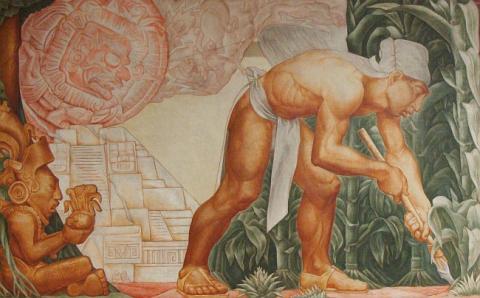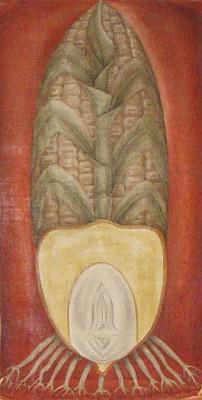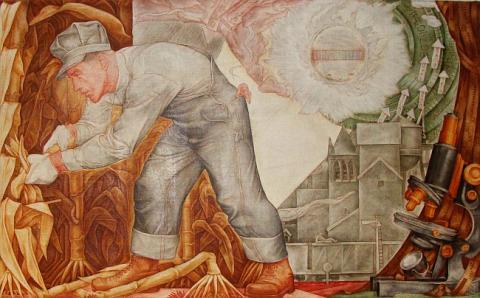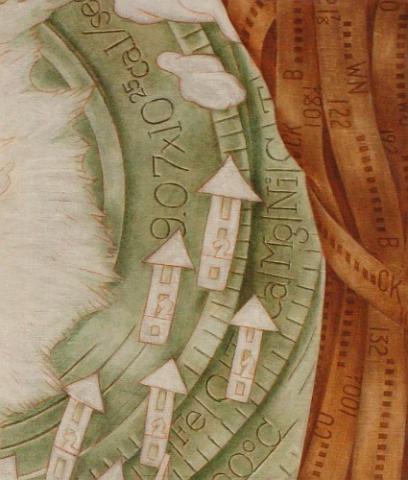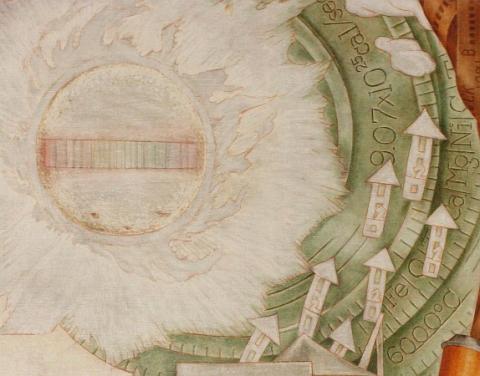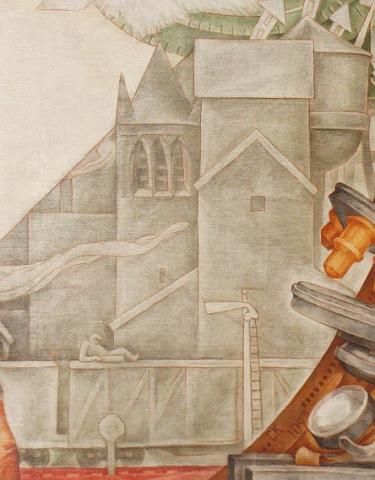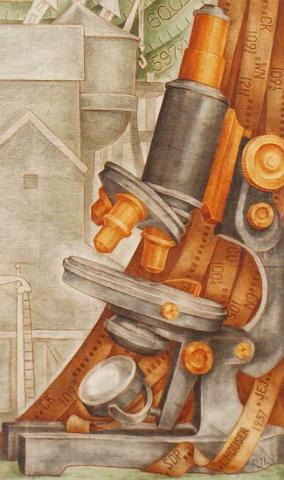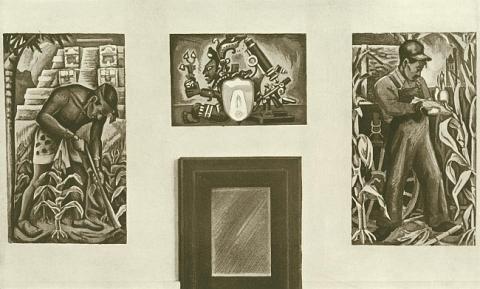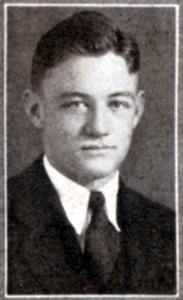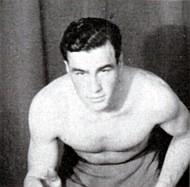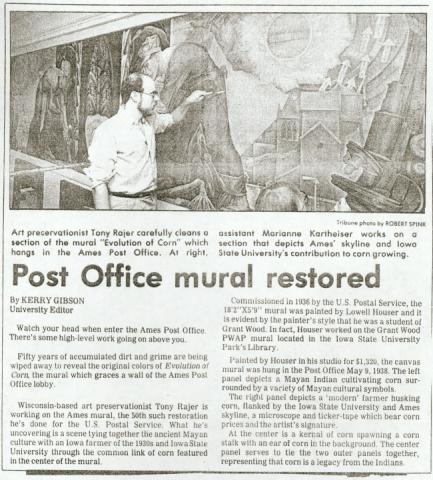Evolution of Corn

Evolution of Corn 1938 By Lowell Houser (1902-1971) Oil on canvas, 18’2” x 5’ 9” North wall of Ames Post Office
One of the most historic works of public art in Ames is the Post Office mural, often taken for granted by residents. It is not only an important contribution to Depression-era art, but one painted by a highly-talented Ames artist, Lowell Houser. The mural was created as part of President Franklin D. Roosevelt’s array of New Deal programs designed to provide work for unemployed artists, create decoration for public buildings, and promote depiction of the American scene. The commissioning agency was the U.S. Treasury Department Section of Painting and Sculpture, a successor to the earlier six-month trial program in 1934, the Public Works of Art Project (PWAP). Houser was awarded a Treasury Dept. contract for the mural on August 1, 1936. He was paid $1,320 for the completed work that was hung on April 20, 1938.
Alert viewers of the Grant Wood murals located in ISU’s Parks Library will recall that Houser’s name is lettered on the text panel crediting all 14 artists assisting with the painting, including another Ames artist, Bertrand Adams. The murals took as their theme a quotation by Daniel Webster: “When tillage begins, other arts follow. The farmers, therefore, are the founders of human civilization.” Houser expanded on this same agrarian theme for his own corn mural in which he contrasted twentieth-century corn production by Midwestern American farmers with ancient cultivation by the Mayans, believed to be the first people to cultivate maize. Of additional interest is the fact that his colleague, Bert Adams, was awarded a contract to create a mural for the Dubuque Post Office during this same period.
DESCRIPTION
Given the symmetry of the two panels, one may easily contrast the two cultivation practices, ancient Mayan on the left, scientific American on the right. Key parallel elements in each half of the mural include:
Left section
a. farmer: Mayan Indian cultivates lush-green maize with an obsidian-tipped hoe; wears headcloth, loincloth, and sandals
b. rain: mask of a Chac (long-nosed god impersonator) as Rain God with lolling tongue, jagged teeth and serpent on forehead; a lightning lizard darts from the dark clouds above a patch of gray rainfall
c. sun: Sun God head within concentric rings
d. temple: white pyramid; smoke rises from burnt offerings; workers recline at base
e. Corn God: holds pot of young corn plants with hieroglyph for maize
Center section:
Ear of corn with superimposed stalk and enlarged dissected seed embryo, all set against a rich red background
Right section:
a. farmer: American picks corn from dried ochre-tone stalks; wears a visored cap, work gloves and shoes, red bandana handkerchief
b. rain: water molecules labeled H2O evaporate skyward (resembling arrows or skyrockets at the upper right corner); one arrow (HHO) falls among gray sheets of rain; hygrometer and air speed streamers to right
c. sun: scientific sun with spots, flaming corona and absorption spectrum superimposed on concentric measuring rings with radiant flux (9.07 x 1025), elements essential for photosynthesis (C, Ca, Fe, Mg, Ni, and O), and sun’s surface temperature (6,000º C.)
d. industry: buildings (ISC campanile and Marston water tower, Ames grain elevator and power plant); crane; freight train box car with rider; railroad semaphore
e. microscope: tickertape cascading to right (B and CK indicate a bid on May corn); artist name L Houser 1937 and sets of initials SDP and JEJ on end of tickertape; initials FJL on base of microscope
ASSISTANTS TO THE ARTIST
S. Dale Phillips (SDP) was a painter, lithographer and teacher in the ISC Architectural Engineering Department, where he taught drawing, painting and lithography from 1927-1943. He learned the art of lithography as a student of the master printer, Bolton Brown, at his studio in Woodstock, New York. Brown is best known for having taught and done printing for the American painter and lithographer, George Bellows. Phillips spent considerable time printing lithographs and etchings for other artists, including Jean Charlot and Dewey Albinson, as well as many Iowa artists such as Lowell Houser. At Iowa State, Phillips was a member of the College Art Committee, a body formed by Pres. Raymond Hughes to enhance student art appreciation. In 1943, Phillips left Iowa State to teach drawing at the Bell Aircraft Corporation, eventually retiring in Red Bluff, California. His connection to the Houser mural project was as advisor.
Lowell Houser preliminary study sketchingA native son was one of two youths employed by Houser as models for the Mayan and American farmers. John Ellsworth Jones (JEJ) was one of five children of John Rutgar and Anna Mae Jones. John R. was the founder of a prominent Ames sheet metal firm in 1914. Each of the Jones boys had a nickname: Newell “Tinner,” “Paul “Gunner,” John Ellsworth “Squirt,” and Clyde “Squeak.” Ellsworth’s nickname stayed with him throughout life and even into death, for “Squirt” appears prominently on his grave marker. He grew up at 1004 Duff and attended nearby Beardshear School. John and his boys were very proud of the copper Bandshell roof they all helped install in 1935, the same year that Ellsworth graduated from Ames High School. The graduate quickly responded when Lowell Houser advertised for paid mural models the following fall of 1936.
The details of his posing for the artist do not survive, although daughter, Corinne Jones, states that the face of the Iowa farmer bears her father’s likeness, and that he spoke of posing for the legs and chest of the Mayan farmer. Nephew, Jerry Jones, also affirms that the face of the American farmer is definitely that of his uncle. After serving in the Army during World War II, Ellsworth returned to Ames where he was employed by the Railway Express Agency, working his way up from delivery van driver to agent master. He died in 1981 and is buried in the Ames Municipal Cemetery. The family tradition was carried on until 1988 with Paul R. Jones Sheet Metal Company, located first at 305 5th Street and then at 364 South Duff (later renumbered 426). Paul’s son, Jerry, now uses the building for his Jones Triad business.
The second youth selected by Houser was Frank J. Linn (FJL), an Iowa State College student studying veterinary medicine. It’s fascinating to note that the Linn family of rural Shelby, Iowa had a tradition of sending their boys to Iowa State as wrestlers. Shelby did not offer high school wrestling, so the boys arrived at Iowa State with only football and basketball experience; yet all achieved recognition as wrestlers. Harry was the first brother (wrestling in 1924), followed by Hugh A. (1926-1930), Frank J. (1933-1938), and Sam (1937-1941). Hugh A.’s son, Hugh R., wrestled for Coach Harold Nichols from 1952-1955.
Frank was a Big Six Champion, wrestling at 145 pounds. He served as team captain from 1937 to1938, and placed third at the NCAA Tournament. Once interviewed by Carol Jensen Phelps for a newspaper article, Linn noted that Frank and five other athletes shared a room under the east bleachers at Clyde Williams Stadium. In the fall of 1936, I heard of a job in the art department posing for an evening art class and I was hired. An athletic supporter was my uniform. The instructor, Lowell Houser, told me he was going to paint a mural and would I pose for him at 50 cents an hour. I was glad to accept the high wages. Working times were arranged to fit into afternoon hours, free of my class schedule, in the winter and spring of 1936-’37 and the fall of 1937. As we worked, Mr. Houser told me about his experiences painting Mayan temples in Yucatan. He knew I was interested in painting, so he had me add some shadowing around a very small part of the final painting and placed his and my initials in the corner as well as those of S.D. Phillips, art department director who served as an advisor.
At this late date, it would be hard to determine each model’s exact contribution to the mural. Jones was short (5 foot-6 inches) and muscular; Linn was equally muscular. Both could have modeled for each farmer. The Mayan and American farmers may reflect at little of each model
VIEWER REACTION TO THE MURAL
“It surely is nice,” or “it’s better than many I’ve seen” seemed to be typical remarks about the mural when first publicly viewed. The contractor, the U.S. Treasury Department, was very pleased with the mural. L.C. Tilden, postmaster at the time the design was selected, noted that he preferred the design over others submitted in the competition. In general, Ames residents reacted quite positively, preferring, like Mrs. Bea Van Scoy Miller of 608 Clark, the Iowa over the Mayan farmer. Several people liked the colors of the left panel, and one expressed appreciation that the mural was not “too flashy.” Some thought the Iowa farmer was leaning too far forward. Mrs. Sabin Nichols (O’Neil Dairy) commented, “If that’s the way you pick corn, I’d hate to live on a farm.” Although there was some discussion on the appropriateness of the farmer’s cap, criticism mainly centered on the difficulty of interpreting the confusing “arrows or skyrockets” representing molecules of “scientific water” in the upper right corner. Indeed, this curator remembers when he was a child endlessly staring at the arrows and trying to figure out their meaning. Only 50 years later did he discover their correct interpretation in an excellent article (see Sources below) by Mary L. Meixner, ISU distinguished professor of art. Readers are encouraged to consult this source for an in-depth analysis of the composition, color scheme, symbolic Mayan elements and details of Houser’s life.
YOUTHFUL ADVENTURES
Born in Chicago, Lowell Houser came to Ames in 1909 with his parents, Mr. and Mrs. Theodore Houser. The family lived at 918 Wilson Avenue. Houser graduated from Ames High School in 1921, attended Iowa State College for a quarter, then launched his art career by studying for three years at the Chicago Art Institute. Yearning for adventure, he traveled to Mexico, where he stayed for three years. There, he studied under Jean Charlot, well-known painter of the Mexican school that included José Orozco and Diego Rivera. He also studied Aztec sculpture in Mexico City museums. His major project was as artist with the Carnegie Institute of Washington expedition to Yucatan where he made drawings of Mayan artifacts being excavated at Chichen-Itza.
Still anxious for more adventure after finishing the Carnegie project, Houser and a Norwegian archaeologist colleague, Gustav Strömsvik, built a sailboat in Mississippi and sailed from New Orleans to Cuba and the Isle of Pines. Unfortunately, the boat capsized during a storm. The sailors were rescued and transported to Haiti, where Houser sketched, painted and did prints of the islanders for a number of months.
HOUSER'S OTHER LOCAL ACTIVITIES
Finally back in Iowa at the start of the Great Depression, Houser was selected by Grant Wood as one of 14 artists to assist in the painting of three mural panels for the Iowa State College Library during 1934. Importantly, Houser was the only artist entrusted by Wood to assist with some of the actual design process. Working in Ames, he sent some designs for the Engineering panels to Wood for reworking.
Throughout the 1930s he was employed as a graphics designer and teacher. Houser worked in oils, water color, and block printing and did numerous book illustrations and magazine covers. Locally, he designed pennants at Collegiate Manufacturing Company and taught free-hand drawing in the Architectural Engineering Department at Iowa State College. In 1936, Houser, along with S.D. Phillips, was elected an officer in Cooperative Artists, an Iowa group working for economic and creative opportunity for artists. He also taught life drawing at the Art Students Workshop in Des Moines, a group that eventually became the Des Moines Art Center. Houser’s artwork was exhibited at venues including the Chicago Art Institute, Metropolitan Museum of Art, Whitney Museum of American Art, Corcoran Gallery, and galleries in San Diego, San Francisco, Des Moines and Cedar Rapids.
In 1938, he was hired by the art department at San Diego State College. His final Iowa commission was accepted in 1939. It was with the Bankers Life Company in Des Moines and called for a set of etched glass windows made with former PWAP artist, Glenn B. Chamberlain. Houser returned to San Diego State after serving in World War II, teaching drawing, painting, and printmaking (his specialty), finally retiring in 1958. He died in 1971 at Fredericksburg, Virginia in a studio home he had designed.
MURAL RESTORATION
After half a century, the corn mural was visibly suffering from accumulated surface grime. Wisconsin-based art conservator, Anton “Tony” Rajer, was commissioned to clean and restore the painting in 1987. The Ames Post Office project was his 50th completed for the U.S. Postal Service. Tony’s credentials include art conservation training at the University of Wisconsin, Harvard University, University of London and the University of Rome. He has written five books and many articles on preservation, exhibited his own photos and paintings in the U.S., Europe, Latin America, and Asia, and was an artist ambassador in Latin America on a Fulbright scholarship.
SOURCES
Articles
Mural Will Be Hung in Ames Postoffice Next Week in Ames Daily Tribune and Times, April 16, 1938.
Postoffice Mural Hung Here Today in Ames Daily Tribune and Times, April 20, 1938.
Many React Favorably to Postal Mural in Ames Daily Tribune and Times, April 21, 1938.
Lowell Houser and the genesis of a mural and The Ames corn mural / by Mary L. Meixner in The Palimpsest, v. 66, no. 1, Jan./Feb. 1985.
From ISU halls to Post Office walls by Carol Phelps in Ames Daily Tribune, May 11, 1985.
Post Office mural restored by Kerry Gibson in The Daily Tribune, Aug. 1, 1987.
Books
Art in federal buildings, v. 1 : Mural designs, 1934-1936. [Washington, D.C.] : Art in Federal Buildings Inc., 1936.
DeLong, Lea Rosson. When tillage Begins, other arts follow: Grant Wood and Christian Petersen murals. Ames, Iowa : University Museums, Iowa State University, 2006.
Marr-Hugunin, Lynn. A History of Wrestling at Iowa State University, 1912-1985. [Ames, Iowa : Nichols' Enterprises], 1986
Ness, Zenobia B. and Orwig, Louise. Iowa Artists of the First Hundred Years [Des Moines, Iowa] : Wallace-Homestead, [c1939].
Interviews
Corinne Jones. Interview, March 22, 2009.
Jerry P. Jones. Interview, March 22, 2009.


